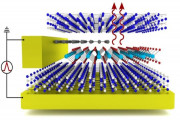 2019-04-16
2019-04-16
A research team at Vienna University of Technology (TU Wien) developed a new kind of LED which generates light from the radiative decay of exciton complexes in extremely thin layers. Researchers produced what they called as “multi-particle exciton complexes” by applying electrical pulses to extremely thin layers of material made from tungsten and selenium or sulphur. These exciton clusters are bonding states made up of electrons and “holes” in the material and can be converted into light. The result is an innovative form of light-emitting diode in whic...
Continue reading →
 2019-04-16
2019-04-16